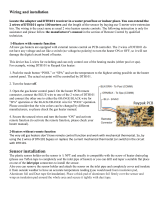
Rev. B 6-23-08 P/N S794
3
Table of Contents
Section 1. Introduction .......................................................................................................... 5
Important Notices ................................................................................................................................................................................. 5
Warranty Information ............................................................................................................................................................................ 5
Code Requirements .............................................................................................................................................................................. 6
Consumer Information and Safety Information ...................................................................................................................................... 6 - 8
General Specifications ......................................................................................................................................................................... 8
Section 2. Installation ............................................................................................................. 9
Heater Description ................................................................................................................................................................................ 9
Sequence of Operation/Putting the Heater into Service ........................................................................................................................ 9
Specifications ...................................................................................................................................................................................... 10
Plumbing Connections .......................................................................................................................................................................... 11
Valves .................................................................................................................................................................................................. 11
Manual By-Pass .................................................................................................................................................................................. 11
Water Connections ............................................................................................................................................................................... 12
Below Pool Installation ......................................................................................................................................................................... 12
Gas Connections ................................................................................................................................................................................. 13
Sediment Traps .................................................................................................................................................................................... 13
Gas Pipe Sizing ................................................................................................................................................................................... 14
Testing Gas Pressure/Gas Pressure Requirements ............................................................................................................................. 15
Outdoor Installation .............................................................................................................................................................................. 16
Outdoor Installation Venting Guidelines ................................................................................................................................................ 17
Indoor Venting—General Requirements (Category I & Category III – clarification) ............................................................................... 18
Heater Clearances ................................................................................................................................................................................ 18
Outside Vent Removal ......................................................................................................................................................................... 18
Combustion Air Supply ......................................................................................................................................................................... 19
Corrosive Vapors and Possible Causes ................................................................................................................................................ 19
Vent Installation (Indoor Installation for U.S. or Outdoor Shelter for Canada) ........................................................................................ 20
Vertical Venting - Negative Pressure ................................................................................................................................................... 20 - 22
Horizontal or Vertical Venting - Positive Pressure ................................................................................................................................ 23
Connecting Special Gas Venting .......................................................................................................................................................... 23 - 25
Outdoor Shelter Installation .................................................................................................................................................................. 26
Garage or Utility Room Installation ....................................................................................................................................................... 26
Control Panel Indexing ......................................................................................................................................................................... 27
Final Installation Check ........................................................................................................................................................................ 27
Electrical Connections .......................................................................................................................................................................... 28
Fireman’s Switch Connection/Remote Control Connections .................................................................................................................. 29
Max-E-Therm
®
Wiring Diagram ............................................................................................................................................................. 30
Electrical Schematic Ladder Diagram ................................................................................................................................................... 31
Section 3. Operation............................................................................................................... 32
Basic System Operation ...................................................................................................................................................................... 32
HSI (Hot-Surface Ignition) Lighting/Operation ....................................................................................................................................... 32
Operating Instructions .......................................................................................................................................................................... 33
To Turn Off Gas to Appliance ............................................................................................................................................................... 33
Safety Controls .................................................................................................................................................................................... 34 - 36
Section 4. Troubleshooting ................................................................................................... 37
Initial Troubleshooting and Troubleshooting Chart ................................................................................................................................. 37
Heater Will Not Fire Troubleshooting .................................................................................................................................................... 38 - 41
LED Diagnostics .................................................................................................................................................................................. 42 - 43
Burner / Heat Exchanger Troubleshooting ............................................................................................................................................ 44
Section 5. Maintenance..........................................................................................................45
Care and Maintenance .......................................................................................................................................................................... 45
Pressure Relief Valve ........................................................................................................................................................................... 45
After Start-Up ...................................................................................................................................................................................... 46
Spring, Fall and Winter Operation ......................................................................................................................................................... 46
Maintaining Pool Temperature ............................................................................................................................................................... 47
Energy Saving Tips .............................................................................................................................................................................. 47
Chemical Balance ................................................................................................................................................................................ 47 - 48
Replacement Parts .............................................................................................................................................................................. 49 - 53




















